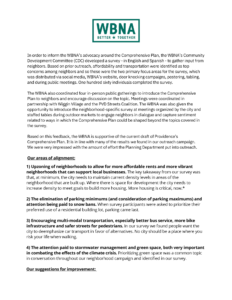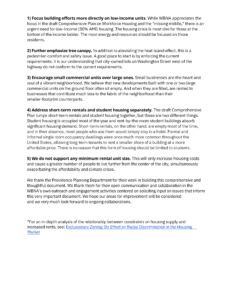In order to inform the WBNA’s advocacy around the Comprehensive Plan, the WBNA’s Community Development Committee (CDC) developed a survey – in English and Spanish – to gather input from neighbors. Based on prior outreach, affordability and transportation were identified as top concerns among neighbors and so these were the two primary focus areas for the survey, which was distributed via social media, WBNA’s website, door knocking campaigns, postering, tabling, and during public meetings. One hundred sixty individuals completed the survey.
The WBNA also coordinated four in-person public gatherings to introduce the Comprehensive Plan to neighbors and encourage discussion on the topic. Meetings were coordinated in partnership with Wiggin Village and the PVD Streets Coalition. The WBNA was also given the opportunity to introduce the neighborhood-specific survey at meetings organized by the city and staffed tables during outdoor markets to engage neighbors in dialogue and capture sentiment related to ways in which the Comprehensive Plan could be shaped beyond the topics covered in the survey.
Based on this feedback, the WBNA is supportive of the current draft of Providence’s Comprehensive Plan. It is in line with many of the results we found in our outreach campaign. We were very impressed with the amount of effort the Planning Department put into outreach.
Our areas of alignment:
1) Upzoning of neighborhoods to allow for more affordable rents and more vibrant neighborhoods that can support local businesses. The key takeaway from our survey was that, at minimum, the city needs to maintain current density levels in areas of the neighborhood that are built up. Where there is space for development the city needs to increase density to meet goals to build more housing. More housing is critical, now.*
2) The elimination of parking minimums (and consideration of parking maximums) and attention being paid to snow bans. When survey participants were asked to prioritize their preferred use of a residential building lot, parking came last.
3) Encouraging multi-modal transportation, especially better bus service, more bike infrastructure and safer streets for pedestrians. In our survey we found people want the city to deemphasize car transport in favor of alternatives. No city should be a place where you risk your life when walking.
4) The attention paid to stormwater management and green space, both very important in combating the effects of the climate crisis. Prioritizing green space was a common topic in conversation throughout our neighborhood campaign and identified in our survey.
Our suggestions for improvement:
1) Focus building efforts more directly on low-income units. While WBNA appreciates the focus in the draft Comprehensive Plan on Workforce Housing and the “missing middle,” there is an urgent need for low-income (30% AMI) housing. The housing crisis is most dire for those at the bottom of the income ladder. The most energy and resources should be focused on those residents.
2) Further emphasize tree canopy. In addition to alleviating the heat island effect, this is a pedestrian comfort and safety issue. A good place to start is by enforcing the current requirements: it is our understanding that city-owned lots on Washington Street west of the highway do not conform to the current requirements.
3) Encourage small commercial units over large ones. Small businesses are the heart and soul of a vibrant neighborhood. We believe that new developments built with one or two large commercial units on the ground floor often sit empty. And when they are filled, are rented to businesses that contribute much less to the fabric of the neighborhood than their smaller-footprint counterparts.
4) Address short-term rentals and student housing separately. The draft Comprehensive Plan lumps short-term rentals and student housing together, but these are two different things. Student housing is occupied most of the year and rent-by-the-room student buildings absorb significant housing demand. Short-term rentals, on the other hand, are empty most of the time, and in their absence, most people who use them would simply stay in a hotel. Formal and informal single room occupancy dwellings were once much more common throughout the United States, allowing long-term tenants to rent a smaller share of a building at a more affordable price. There is no reason that this form of housing should be limited to students.
5) We do not support any minimum rental unit size. This will only increase housing costs and cause a greater number of people to live further from the center of the city, simultaneously exacerbating the affordability and climate crises.
We thank the Providence Planning Department for their work in building this comprehensive and thoughtful document. We thank them for their open communication and collaboration in the WBNA’s own outreach and engagement activities centered on soliciting input on issues that inform this very important document. We hope our areas for improvement will be considered and we very much look forward to ongoing collaborations.
*For an in-depth analysis of the relationship between constraints on housing supply and increased rents, see: Exclusionary Zoning: Its Effect on Racial Discrimination in the Housing Market


